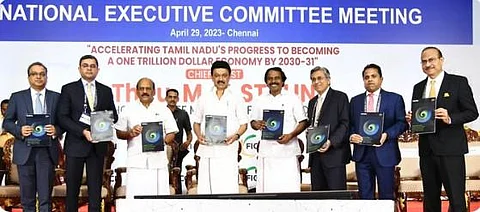

CHENNAI: To achieve the target of a trillion-dollar economy by 2030, Tamil Nadu will need to grow at 16.5% on average, which is way above the current rate of growth of 10%, according to a report by Deloitte.
The report, which was released by Chief Minister M K Stalin on Saturday, said going by the current rate, the state may reach the target only by 2034. The report stressed the need to introduce path-breaking policies and economic planning to attract investments, enhance production and expand exports to achieve higher growth, adding that the state would need to climb up the value chain in primary, secondary and tertiary sectors.
The primary sector is required to grow at 16%, while the manufacturing and professional services sectors are at 18%. The state will need to bring in strategic investments over the next seven years to achieve the required sectoral growth, said the report. The Deloitte Knowledge Paper on ‘Accelerating TN’s progress to becoming one trillion-dollar economy by 2030-31’ was released at the national executive meeting of FICCI.
T M Anbarasan, minister for MSME, and T Mano Thangaraj, minister for Information Technology, were present on the occasion. The report also stressed the need for the state to focus on electric vehicles and food processing. Other segments it highlighted include technical textiles, chemicals and non-metallic minerals, electronics, and semiconductors, MSME revitalisation, and renewable energy.
It highlighted the need to focus on key electric vehicle cities like Chennai, Coimbatore, Trichy, Madurai, Salem and Tirunelveli, with the goal of making the state the preferred destination for EV manufacturing in South East Asia. The state will need to intervene in infrastructure creation, start-up support and social development.
Dr KR Shanmugam, director and professor of Madras School of Economics, said the chance of achieving a trillion-dollar economy by 2030-31 has to be ruled out. It requires a nominal annual growth rate of 18.2%, and on the assumption of inflation of 5%, a real growth rate of 13.2%.
“The current level of debt-GSDP ratio is a hindrance to growth. It suggests that ensuring 14% nominal (9% real) growth of the economy, the state should target a revenue surplus from 2023-24 such that it contains its fiscal deficit to only 2% level to obtain the sustainable threshold debt level of about 18% in 2034-35, which will help the state to attain USD 1 trillion economy target,” he said.
The report stated that there is a potential to employ over 5,000 professionals in the research and development space alone, which would contribute Rs 1,000-Rs 1,500 crores in GDP. The food processing sector would also benefit from cluster development. This can be enabled via a one-district-one-food design. Each district can be mapped to a key food item that it would process. Agri-MSMEs could play a key role in providing district-specific agricultural inputs, micro-cold storages, pack houses, and greenhouses.
Stating that exports of textiles to Europe have dwindled by 45% post the Russia-Ukraine war, the report said the state should aim to help textile industries diversify their export destinations by providing market intelligence. The report also highlighted that the chemical sector, based on its current size (around $6 billion) will have to grow more than 10 times in a span of just eight years.